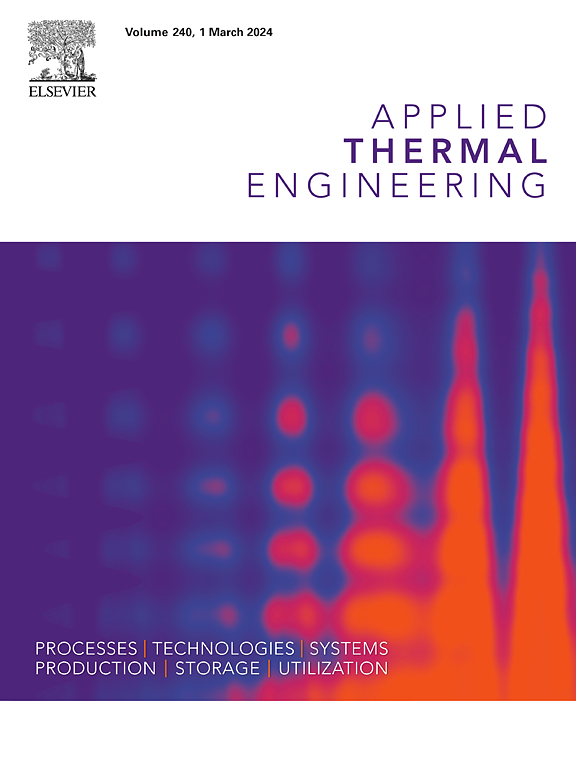纵向通风对隧道多火源火灾着火特性影响的实验研究
IF 6.9
2区 工程技术
Q2 ENERGY & FUELS
引用次数: 0
摘要
隧道是狭长的密闭空间,一旦发生火灾,在火焰和热烟的作用下,通常涉及多个点火源。然而,与许多现有研究中同时点火的常见假设不同,真实的隧道火灾通常具有顺序点火的特征,其中主要火源随着时间的推移点燃周围的可燃物。此外,纵向通风作为隧道中最常用的通风方式,对隧道火灾的着火特性有许多复杂而矛盾的影响。因此,本研究通过研究纵向通风条件下多个油藏火灾的顺序点火行为来解决这一关键问题。得到了温度、气体浓度和辐射热通量的数据。结果表明:纵向通风条件下,隧道多源火灾有两种典型的着火情况。相邻油底壳的点火时间间隔随着风速的变化呈现出不同的规律,但总体而言,第三油底壳的点火时间间隔要短于第二油底壳;随着油底壳着火的顺序,相邻油底壳的燃烧持续时间越来越短。此外,当v = 0 m/s时,顶棚烟气峰值温度呈对称分布,上游顶棚气体浓度随油底壳点火过程的变化而变化。当v >;0 m/s时,上游顶板附近峰值温度与环境温度保持接近,上游顶板气体浓度基本无明显变化。将多个点火源作为一个整体考虑,可以发现多个点火源下游的天花板气体温升呈指数衰减。因此,针对每个临界点火状态,提出了隧道多火源下游烟气温升的预测公式。本研究的结果有助于人们对隧道多源火灾的着火过程有一个全面的认识。本文章由计算机程序翻译,如有差异,请以英文原文为准。
Experimental study on the effect of longitudinal ventilation on the ignition characteristics of fires with multiple ignition sources in tunnels
Tunnels are long, narrow and confined spaces, and in the event of a fire, multiple sources of ignition are usually involved under the action of flames and hot smoke. However, unlike the common assumption of simultaneous ignition in many existing studies, real tunnel fires typically feature sequential ignition, where a primary fire source ignites surrounding combustibles over time.
Moreover, longitudinal ventilation, as the most common ventilation method in tunnels, has many complex and contradictory effects on the ignition characteristics of tunnel fires. Therefore, this study addresses this critical by investigating the sequential ignition behavior of multiple oil pool fires under longitudinal ventilation conditions. Data on temperature, gas concentration and radiant heat flux were obtained. The results show that there are two typical ignition conditions for multi-source fires in tunnels under longitudinal ventilation conditions. The ignition time intervals of adjacent oil pans show different patterns with the change of wind speed, but in general, the ignition time intervals of the third oil pan are shorter than those of the second oil pan; and the combustion durations of adjacent oil pans become shorter and shorter with the sequence of oil pan ignition. In addition, when v = 0 m/s, the peak temperature of the ceiling flue gas is symmetrically distributed, and the concentration of the upstream ceiling gas varies with the ignition process of the oil pan. When v > 0 m/s, the peak temperature near the upstream ceiling remains close to ambient levels, and the gas concentration of the upstream ceiling basically has no obvious change. Considering the multiple ignition sources as a whole, it can be found that the temperature rise of the ceiling gas downstream of the multiple ignition sources is exponentially decaying. Therefore, for each critical ignition state, a prediction formula for the temperature rise of the smoke gas downstream of the tunnel multi-fire source is proposed. The results of this study help people to have a comprehensive understanding of the ignition process of tunnel multi-source fires.
求助全文
通过发布文献求助,成功后即可免费获取论文全文。
去求助
来源期刊

Applied Thermal Engineering
工程技术-工程:机械
CiteScore
11.30
自引率
15.60%
发文量
1474
审稿时长
57 days
期刊介绍:
Applied Thermal Engineering disseminates novel research related to the design, development and demonstration of components, devices, equipment, technologies and systems involving thermal processes for the production, storage, utilization and conservation of energy, with a focus on engineering application.
The journal publishes high-quality and high-impact Original Research Articles, Review Articles, Short Communications and Letters to the Editor on cutting-edge innovations in research, and recent advances or issues of interest to the thermal engineering community.
 求助内容:
求助内容: 应助结果提醒方式:
应助结果提醒方式:


